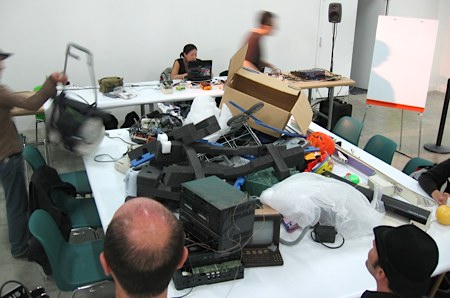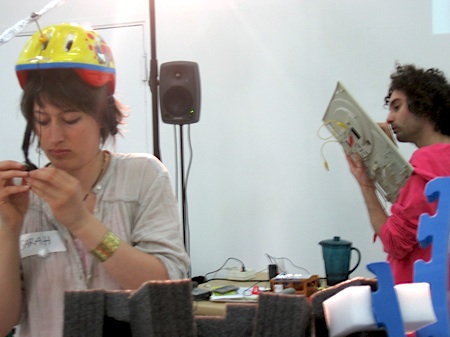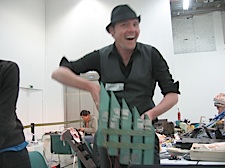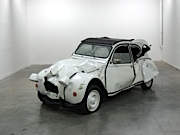7 min read 🤓
Strange things with and without electrickery
may 13, 2009.
And here is a picture of the fruit of sunday april 19th's junk-hunt as it was piled up four days later on a table in the Palais de Tokyo in Paris, at the start of the Scrapyard Challenge Workshop led by Jonah Brucker-Cohen and Katherine Moriwaki.

During the workshop, which started at about 14h, and ended with a final presentation some time around 20h, I used my digital photo camera to shoot a series of short clips that I spun together in the following concise uTube, somewhat in the style and spirit of Rébus as whose replace-man I acted that thursday:
The video will give you a good impression of all the bric-à-brac that came together in the Palais, and how much of that was put to work during Jonah and Katherine's workshop.
The workshop's main 'technical lesson' can best be summarized in the following slogan:
to move = to control = to play
Moving parts (anything that moves or can be made to do so, from one state to a next one) can function as a switch.
A switch may be digital, allowing you to chose between 0 (off) and 1 (on). A switch may also be
analog:
then it enables one to access a (continuous) range of values, between a min and a max.
Using a switch, you may control.
And as soon as you control a mechanism that enables the production of sound, you actually have built an instrument: now
you can play ...

The main part of the workshop had the participants investigate and use the manifold ways movable parts of the discarded toys and machines could be put to work to control MIDI sound playback. This would ask for covering and/or replacing parts with aluminum foil or other conductive material (for the digital - contact - switches), fixing a photodiode in the path of a movement (for an analog - continuous - switch), or sometimes for some combination of both. All then was connected with bits and pieces of electric wire via a couple of Arduino boards to a laptop patched-up to play a library of basic MIDI instruments.
 In
the picture there's James demonstrating the MIDI
'accordion' that he put together from a green plastic tip-out file holder,
using thin metallic shutters (taken from a bunch of discarded computer
floppy disks) as contact points. In
the video you can see James's scrapyard accordion in action.
In
the picture there's James demonstrating the MIDI
'accordion' that he put together from a green plastic tip-out file holder,
using thin metallic shutters (taken from a bunch of discarded computer
floppy disks) as contact points. In
the video you can see James's scrapyard accordion in action.
Jonah and Katherine suggested transforming an old scanner into a MIDI
controller, and so I did, with the help of Vincent. Using some
bits of aluminum foil as contacts, opening the lid would trigger
the playing of a sound, of which then the frequency could be modulated by
moving the scanner's lid up and down, because of the photodiode
that we attached to the scanner's glass surface. In the third and last section
of the uTube reportage you
see Vincent playing the scanner during the Scrapyard Challenge's Final
Jam.
The Scrapyard Challenge workshop was the sixth and last in a series of Dorkbot events this spring in the Palais de Tokyo, on the occasion of the Gakona exposition, from february 12th till may 3rd this year. Gakona is in Alaska. It is not even officially a village or hamlet. It is - as Wikipedia learns us - a census-designated place, that is, a 'concentration of population' identified for statistical purposes: it lacks separate municipal government, but otherwise it physically resembles something like a village. Just north of Gakona is the site of the American High-frequency Active Auroral Research Program (HAARP), set up to conduct experiments in ionospheric phenomena, and subject to ongoing controversy as to possible damaging effects of the experiments, as well as of the eventual military use of their possible outcomes (weapon? climate control?). The transmission of electricity in the uppermost part of the atmosphere goes back to the pioneering work of Nikola Tesla.
If ever a mortal did strange things with electricity ...
![Roman Signer - Parapluies [photo: Palais de Tokyo] signer parapluies](../../Pics/SB/PdT_Gakona.jpg) Spirit
and specter of Nikola Tesla quite naturally pervaded the little Gakona
in the Palais de Tokyo these past couple of months; at least as
much as they do the HAARP site, up out there in northern Alaska. The exhibition
consisted in a number of pieces of art/science fiction/bricolage
by four different artists, the force of the most convincing among which
resided not so much in their materiality, but rather in the (invisible) tension
their presence created in the - large - space that surrounded them. Spaces
that looked empty, but that actually were full to the brim - with,
yeah, the tickling and tides of a luminiferous
aether surfed on by a number of ghosts ...
Spirit
and specter of Nikola Tesla quite naturally pervaded the little Gakona
in the Palais de Tokyo these past couple of months; at least as
much as they do the HAARP site, up out there in northern Alaska. The exhibition
consisted in a number of pieces of art/science fiction/bricolage
by four different artists, the force of the most convincing among which
resided not so much in their materiality, but rather in the (invisible) tension
their presence created in the - large - space that surrounded them. Spaces
that looked empty, but that actually were full to the brim - with,
yeah, the tickling and tides of a luminiferous
aether surfed on by a number of ghosts ...
Three of the works in the show addressed these 'spirits' quite directly.
The specter of Tesla's is at the heart of Roman Signer's Parapluies (see picture). From quite a distance one looked at a 'sculpture' consisting of two tesla coils topped by two black umbrellas. Most of the time the 'machine' was charging, though of course this was something one could not 'see'. Then, every five or ten minutes or so, there was a spectacular lightning & sulfurous discharge between the ends of the two umbrellas, which lasted for about 7 or 8 seconds and was accompanied by a loud, penetrating sound, not unlike that of a car horn ( * ).
Second there's the specter of electric power unseen, re-presented in Micol Assaël's Chizhevsky lessons. Micol literally charged a huge empty space with static electricity, that visitors - after due warning and precautions - could be in and walk through ... Something was out there, but despite its undeniable physicality, the work's material (the anionized particles of air) remain hidden to the eye. ( ** ).
The third specter is that of the Gakona (conspiratorial) rumors and narrative. Laurent Grasso's HAARP is a spatial, very geo-sym-metrical, construct built from metal poles and wires, connected to a pattern of black boxes on the floor. It looks a lot like the field of antennas used at the HAARP site to direct signals into the ionosphere, as one can see on photographs from Gakona. Visitors are not allowed to enter Grasso's 'metal cave', even though the antennas apparently are 'not wired': there is 'nothing' running through them or being emitted. They are merely evoking the Gakona specter. Or are they? ...
The other works that together with these three made up the Gakona show I found interesting, but superfluous in this specific context. Had I been Gakona's curator, I would have limited the exhibition to just the three mentioned above, which together constitute a forceful and very convincing triptych, depicting the ghosts and powers that 'electrickery' may unleash: they are (spectacularly) visible in 'Parapluies', get feel-able in 'Chizhevsky lessons', to finally in 'HAARP' become merely thinkable ...
History taught us that especially this last species of specters is a very, very vicious one ...
[ For a visual Gakona impression and a short interview with Laurent
Grasso see
this short reportage on Vernissage TV.
Previous related SB-entry: Junk
me up, Scotty! ]
notes __ ::
(*)  The
first evening that I was at the Palais de Tokyo during the Gakona
exhibition, on march 5th, I did not visit the expo, but went directly to
the Dorkbot lecture evening, which was that day all about 'Brainwaves'.
All the Brainwaves lectures of course were accompanied by the persistent
regular sounding of the 'Tesla alarm', which, however, at the time I - rather
interestingly - mistook for the sound made by another installation,
the Expanded Crash (see picture), by Florian Pugnaire and David
Raffini, which actually was completely unrelated to the Gakona expo, but
stood in the room next to that of the Parapluies. As I
had so far only seen the 'jam karet' demolition of the little 2CV, I unquestionably
interpreted the sound I heard as being that of the crashing car's horn ... :-)
[ ^ ]
The
first evening that I was at the Palais de Tokyo during the Gakona
exhibition, on march 5th, I did not visit the expo, but went directly to
the Dorkbot lecture evening, which was that day all about 'Brainwaves'.
All the Brainwaves lectures of course were accompanied by the persistent
regular sounding of the 'Tesla alarm', which, however, at the time I - rather
interestingly - mistook for the sound made by another installation,
the Expanded Crash (see picture), by Florian Pugnaire and David
Raffini, which actually was completely unrelated to the Gakona expo, but
stood in the room next to that of the Parapluies. As I
had so far only seen the 'jam karet' demolition of the little 2CV, I unquestionably
interpreted the sound I heard as being that of the crashing car's horn ... :-)
[ ^ ]
(**) Though many others mentioned the curious effects and 'feel' of being inside
the 'charged space', my own experience of the Chizhevsky lessons
was - at least I think so - fully 'psychological'.
Or is it that I am relatively insensitive to static? But then how comes?
Walking - alone - in the space demarcated by the 20 or so copper plates,
I actually did not 'feel' nor 'see' anything special, except the (interior)
sense and 'tension' of 'imminent danger', that was undoubtedly caused by the explicit
warnings at the entrance of the hall: entrance is forbidden for holders
of pacemakers, hearing aids or other electronic protheses, pregnant women
and children under eight; others are urged to turn off all electronic
devices, warned to avoid touching other visitors' faces (especially the
eyes), and asked to sign a disclaimer ... [
^ ]
tags: junk, scrapyard challenge, Paris, Nikola Tesla, Gakona
# .307.
...
comments for Strange things with and without electrickery ::
|
Comments are disabled |